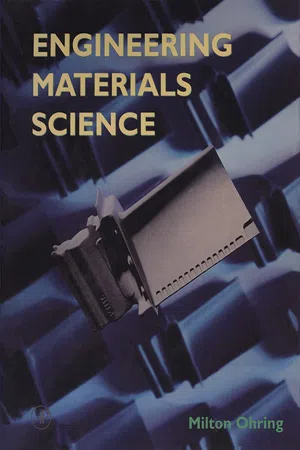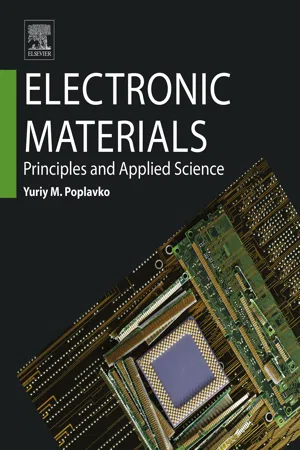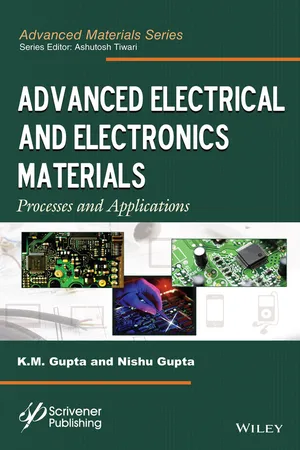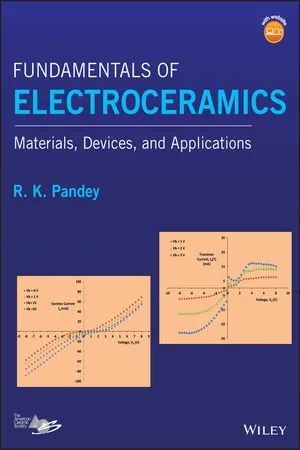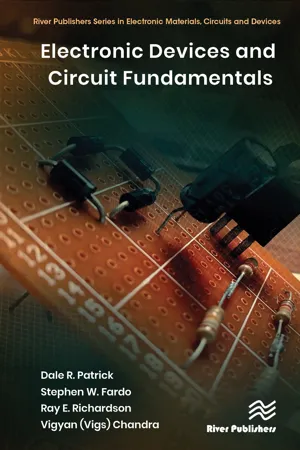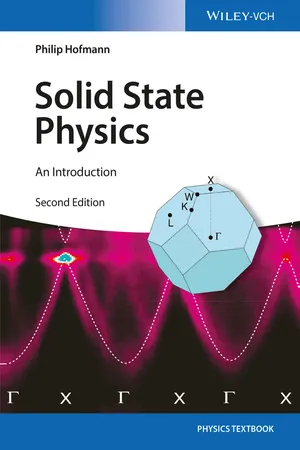Technology & Engineering
Semiconductors
Semiconductors are materials with electrical conductivity between that of a conductor and an insulator. They are the foundation of modern electronics, serving as the basis for transistors, diodes, and integrated circuits. By controlling the flow of electrical current, semiconductors enable the functionality of electronic devices such as computers, smartphones, and solar cells.
Written by Perlego with AI-assistance
Related key terms
Related key terms
1 of 4
Related key terms
1 of 3
11 Key excerpts on "Semiconductors"
- eBook - ePub
- Milton Ohring(Author)
- 1995(Publication Date)
- Academic Press(Publisher)
12 SEMICONDUCTOR MATERIALS AND DEVICES: SCIENCE AND TECHNOLOGY 12.1 INTRODUCTION Semiconductors are a unique class of materials that have transformed society and technology in truly revolutionary ways. A reasonably large number of different semiconductor materials are used in assorted electronic and electro-optical devices. They are broadly divided into elemental and compound Semiconductors. The relevant portion of the Periodic Table for these materials is indicated in Fig. 12-1. Elemental Semiconductors stem from column IVA and notably include silicon, the most important of all Semiconductors. In addition, there is germanium, the first semiconductor to be widely exploited in devices. Today, Ge has been virtually entirely supplanted by Si. Carbon in the form of diamond is also semiconducting. Diamond’s semiconducting properties have not yet been capitalized upon, but its remarkably high thermal conductivity has been used to draw heat away from semiconductor lasers, enabling them to operate more reliably. FIGURE 12-1 Elements of the Periodic Table that play an important role in semiconductor technology. Compound Semiconductors are composed of elements drawn almost entirely from four columns of the Periodic Table, with two residing on one side next to column IVA and two adjacent to it on the other side. Columns IIB and IIIA, containing metals with nominal valences of 2 and 3, respectively, thus combine with the nonmetals of columns VA and VIA that have respective valences of 5 and 6. Important elemental and binary semiconductor materials are listed in Table 12-1, together with a complement of physical and electrical properties whose meanings will become clearer as the chapter develops. It is interesting to note that the compounds are either of the III–V type (e.g., GaAs, InP) or the II–VI type (e.g., CdTe, ZnS). Thus, eight electrons are available (3 + 5 = 8 or 2 + 6 = 8) to be shared by the atoms - eBook - ePub
Electronic Materials
Principles and Applied Science
- Yuriy M. Poplavko(Author)
- 2018(Publication Date)
- Elsevier(Publisher)
exponential increase in electrical conductivity with temperature rise. Near absolute zero Semiconductors are close to insulators.- 2.
Semiconductors are crystals with a bandgap in electronic spectrum, which is in the range of 0.1–2.5 electron-volts. For example, gallium arsenide can be grouped under wide-gap Semiconductors, while indium arsenide is a narrow-gap semiconductor. Among Semiconductors there are some chemical elements (germanium, silicon, selenium, tellurium, arsenic, etc.), several alloys, and compounds. Almost all inorganic materials of the surrounding world are Semiconductors. In nature, the most common semiconductor is silicon that occupies almost 30 percent of the earth's crust.- 3.
Semiconductors have conducting as well as dielectric properties. In semiconductor crystals, atoms are usually joined by covalent bonds (i.e., pair of electrons bounded with two atoms); these electrons require a certain level of internal energy to release from atom that characterize the difference between Semiconductors and dielectrics. This energy can be applied by energy fluctuations in crystal (room temperature thermal energy level is 0.026 eV).- 4.
The analysis of Schrodinger equation for electrons in crystal (Bloch theorem) shows that electronic wave function depends on the wave vector k that module has a dimension of inverse length; by this way, the quasi-impulse p = ħk can be introduced in a consideration. This concept is very useful for examining many problems in electronic theory of solids.- 5.
In crystalline Semiconductors, spatial atomic structure has long-range ordering, that is, the position of individual atoms (or groups of atoms) is repeated periodically within volume of crystal. Accordingly, the potential field is periodically changed with distance, divisible to period of structure. The compact recording of this condition is: U (r ) = U (r + na ), where a is period of structure and n - eBook - ePub
- Pradeep Fulay, Jung-Kun Lee(Authors)
- 2016(Publication Date)
- CRC Press(Publisher)
3 Fundamentals of Semiconductor MaterialsKEY TOPICS- Origin of semiconductivity in materials
- Differences between elemental versus compound, direct versus indirect band gap, and intrinsic versus extrinsic Semiconductors
- Band diagrams for n-type and p-type Semiconductors
- Conductivity of Semiconductors in relation to the majority and minority carrier concentrations
- Factors that affect the conductivity of Semiconductors
- Device applications such as light-emitting diodes (LEDs)
- Changes in the band gap with temperature, dopant concentrations, and crystallite size (quantum dots)
- Semiconductivity in ceramic materials
3.1 INTRODUCTION
Semiconductors are defined as materials with resistivity (ρ) between ~10−4 and ~103 Ω · cm. An approximate range of sensitivities exhibited by silicon (Si)-based Semiconductors is shown in Figure 3.1 . Elements showing semiconductivity are called elemental Semiconductors (e.g., silicon), and the compounds that show semiconducting behavior are known as compound Semiconductors (e.g., gallium arsenide [GaAs]). A band diagram of a typical semiconductor is shown in Figure 3.2 . For most Semiconductors, the band gap energy (E g ) is between ~0.1 and 4.0 eV. If the band gap is larger than 4.0 eV, we usually consider the material to be an insulator or a dielectric. In this chapter, we will learn that the composition of such dielectric materials can be altered so that they exhibit semiconductivity (see Section 3.21 ). As shown in Figure 3.2 , the top of the valence band is known as the valence band edge (E v ), and the bottom of the conduction band is known as the conduction band edge (E c ). Recall from Chapter 2 that the band diagram shows the outermost part of the overall electron energy levels of a solid. The vertical axis shows the increasing electron energy. Thus, the magnitude of the band gap energy (E g - eBook - ePub
Advanced Electrical and Electronics Materials
Processes and Applications
- K. M. Gupta, Nishu Gupta, Ashutosh Tiwari(Authors)
- 2015(Publication Date)
- Wiley-Scrivener(Publisher)
Chapter 6Semiconducting Materials: Properties and Behaviour6.1 Introduction to Semiconductors
These are the solids having energy gap Eglying in between those of the conductors and insulators. Their conductivity is more than that of the dielectrics but less than that of conductors. They are basically electronic materials. Semiconductors are available in following forms.- Elements such as silicon (Si) and germanium (Ge).
- Compounds such as GaAs, InP, AlSb, CdTe, ZnSe etc.
- Alloys such as GaAsxP1−x, HgCdxTe1−xetc.
- Intrinsic, and
- Extrinsic.
- n-type
- p-type
The elemental forms of pure Si and pure Ge are intrinsic. In intrinsic form they are not useful. They are, therefore, doped by dopants to make extrinsic Semiconductors. Extrinsic forms are directly useful and are widely employed in manufacturing of the solid state devices. They belong to the category of alloys and compounds. Electronics industry requires a purity better than 1: 109 in pure Si and Ge.Extrinsic Semiconductors are primarily of n-type and p-type. They may be in compound form such as GaAs, CdTe etc. or in alloy form such as HgCdxTe1−x. A number of semiconducuting compounds are available in oxide, halide and sulphide forms also. The n and p-types are used to make n-p junction for diode, n-p-n and p-n-p for transistor, etc.6.1.1 Properties of Semiconductors
Semiconductors are generally hard and brittle, and possess negative coefficient of temperature resistance. In contrast with conductors whose conductivity increases with purification, the conductivity of Semiconductors decreases with purification. Semiconductors are widely used as rectifiers, amplifiers, photocells etc. Their properties are of greater importance in telecommunication, power electronics, computer hardware etc. Complete details about them are given in this and later chapters. - eBook - ePub
Fundamentals of Electroceramics
Materials, Devices, and Applications
- R. K. Pandey(Author)
- 2018(Publication Date)
- Wiley-American Ceramic Society(Publisher)
7 Elements of A Semiconductor Chapter Menu 7.1 Introduction 7.2 Nature of Electrical Conduction in Semiconductors 7.3 Energy Bands in Semiconductors 7.4 Origin of Holes and n‐ and p‐Type Conduction 7.5 Important Concepts of Semiconductor Materials 7.6 Experimental Determination of Semiconductor Properties Problems Science is not only a discipline of reason but, also, one of romance and passion. Stephen Hawking 7.1 Introduction Semiconductor materials dominate modern electronics and microelectronics technology and have greatly influenced our civilization. Their impact is second to none in each and every aspect of our lives. There is hardly any device that we use in our daily life that has remained immune from the impact of Semiconductors be it a child's simple toy or a spaceship exploring the universe in quest of knowledge. We all are familiar with the words diode, transistors, electronic switches, amplifiers, etc. They are ubiquitous in our lives, and it is hard to imagine how the modern society could even function without these wonder devices. We use a block diagram shown in Figure 7.1 to introduce our readers to the essential elements of semiconductor materials and devices. It is nevertheless just a brief representation of the field and, by no means, can the vastness of semiconductor technology be encompassed in one single figure. We have tried to do justice to this subject in this chapter particularly in describing the theoretical aspect of the semiconductor phenomenon relevant to the understanding of the nature and properties of electroceramic Semiconductors that we will cover in the next chapter - eBook - ePub
Electric Aircraft Dynamics
A Systems Engineering Approach
- Ranjan Vepa(Author)
- 2020(Publication Date)
- CRC Press(Publisher)
11 Semiconductors and Power Electronics11.1 Semiconductors and Transistors
11.1.1 Semiconductors and Semiconductor Diodes
Of the different types of electronic bonding, namely, ionic, covalent, metallic and van der Waal bonding, Semiconductors are characterized by covalent bonding which involves the bonding by sharing of the four electrons in the outer shell. There are seven major crystalline structures in materials, namely, cubic, tetragonal, rhombic, monoclinic, triclinic, trigonal and hexagonal, with 32 sub-categories. Semiconductors generally belong to the face-centered cubic category where the valency electrons are joined by covalent bonds. The distinguishing features of Semiconductors are their crystalline structure which leads to the temperature sensitivity of resistance, sensitivity of conductivity to impurities or dopants, the availability of free electrons, leading to electron and hole conductivity and a narrow band gap between the outer conduction band of electrons and the inner valency band. Intrinsic Semiconductors are naturally occurring Semiconductors, while extrinsic Semiconductors conduct electricity due to the presence of impurities. Thus Semiconductors could be “doped” with an impurity, of which there are two types. The two types of impurities are the pentavalent or “n ”-type impurities, such as antimony, arsenic and phosphorus that have a free electron to share, and trivalent or “p ”-type impurities, such as indium, gallium and boron that have a free hole or one less electron. Thus, in a “p ”-type semiconductor there is an excess of holes which can be considered to be the majority carriers of current, while in an “n - eBook - ePub
- Dale R. Patrick, Stephen W. Fardo, Ray E. Richardson, Vigyan (Vigs) Chandra(Authors)
- 2023(Publication Date)
- River Publishers(Publisher)
1Semiconductor FundamentalsThis chapter deals with the theory of materials that are used in the construction of electronic devices called solid-state. Solid-state devices are made of semiconductor material. You may recall from your studies of DC and AC electronics that a semiconductor is a solid material that has electrical properties that lie somewhere between those of a conductor and an insulator. Semiconductors have made possible such things as radio, television, computers, robots, smart phones, and electronic sound systems.Semiconductor theory focuses on the flow of current carriers through semiconductor material. A basic understanding of semiconductor theory will enable you to understand the electrical characteristics of solid-state devices and how they operate.Objectives
After studying this chapter, you will be able to:- 1.1 describe the structure and properties of an atom;
- 1.2 compare and contrast ionic bonding, covalent bonding, and metallic bonding;
- 1.3 explain the electrical difference between conductors, Semiconductors, and insulators;
- 1.4 explain how current carriers move through Semiconductors;
- 1.5 analyze and troubleshoot Semiconductors.
Chapter Outline
- 1.1 Atomic Theory
- 1.2 Atom Bonding
- 1.3 Insulators, Semiconductors, and Conductors
- 1.4 Semiconductor Materials
- 1.5 Analysis and Troubleshooting – Semiconductor Materials
Key Terms
atom atomic numberatomic weight breakdown voltage compound covalent bonding doping electron electron volt element extrinsic material forbidden gap intrinsic material ionic bonding matter metallic bonding molecule neutron N-type material nucleus orbital proton P-type material valence electrons1.1 Atomic Theory
Nearly every study of electronic devices starts with an investigation of atomic theory. Atomic theory describes the structure of matter and the atom. It is necessary for you to learn this information so that you will be able to understand how semiconductor material responds when energy, such as electricity and heat, is applied. - eBook - ePub
Solid State Physics
An Introduction
- Philip Hofmann(Author)
- 2015(Publication Date)
- Wiley-VCH(Publisher)
doped Semiconductors. Finally, we shall briefly discuss the basic working principles of some semiconductor devices.7.1 Intrinsic Semiconductors
In this section, we discuss the properties of pure (intrinsic) Semiconductors. Since a very small number of impurities has a strong impact on the behavior of Semiconductors, this intrinsic state is hard to realize and also of little technological relevance. However, many of the concepts we explore here can be easily transferred to the case of doped Semiconductors that we treat in the next section.A semiconductor or insulator is, by definition, a solid for which the chemical potential at zero temperature is placed at an energy where the density of states is zero. In other words, there is a certain energy band that is completely filled, and the next band at higher energy is completely empty. This situation is schematically shown in Figure 7.1 a. The highest occupied band and the lowest unoccupied band are called the valence band (VB) and the conduction band (CB), respectively. At finite temperature, the electrons have to be distributed according to the Fermi–Dirac distribution shown in Figure 7.1 b. This leads to some missing electrons in the VB and some extra electrons in the CB. In order to calculate the resulting electron concentrations, we have to know the position of the chemical potential. 1 We can find this based on the argument of charge neutrality: The excited electrons in the CB must clearly come from the VB, and we must thus have as many extra electrons in the CB as missing electrons in the VB. This requirement determines the position of the chemical potential. To see this, suppose that the chemical potential is just above the valence band maximum (VBM). This would result in a density of occupied states as shown in Figure 7.1 c. Many states would be emptied in the VB, but only few states would be populated in the CB. In other words, the total number of electrons would have decreased and the solid would be charged positively, violating charge conservation. An equivalent argument can be made for a chemical potential just below the conduction band minimum (CBM), which would lead to a negatively charged solid. Consequently, we see that the chemical potential must lie close to the middle of the gap between the VBM and the CBM (Figure 7.1 d). At a finite temperature, this leads to an equal number of missing electrons in the VB and excited electrons in the CB. Note that the temperature for the distribution in Figure 7.1 b was chosen to be very high in order to make the effects in Figure 7.1 - eBook - ePub
- Michel Le Bellac(Author)
- 2013(Publication Date)
- WSPC(Publisher)
In most present applications, it has been replaced by the field effect transistor, mostly its MOS (Metal/Oxyde/Semiconductor) version where the three electrodes are the source, the grid and the drain. A small voltage variation applied to the grid generates important variations of the current between the source and the drain. This MOS transistor allows one to build amplifiers and switches: it is the latter property which makes the transistor an ideal tool for binary logic. The decisive technological break through was the birth of integrated circuits: instead of joining together the different elements of an electronic device by wires, the transistors were directly etched by photolithography together with the passive elements (resistors, capacitors. . .) on a semiconductor wafer, in general a silicon plate, in order to build electronic chips. The expression “microelectronics” arose as the size of the transistors was reduced to micrometer dimensions, and even beyond. We reach today dimensions on the order of 40 nanometers, with billions of transistors etched on a single chip, about 10 millions transistors per mm 2. This downsizing of transistors is at the origin of “Moore’s law”, which states that the computing power of our laptops is multiplied by two every eighteen months. For different reasons, it turns out that this “law” seems to also be valid for computer memories. 6.3 Interaction with an electromagnetic field Semiconductors, and in particular silicon, are used extensively in today’s electronics, as witnessed by the expression “Silicon Valley” in California. Modern electronics is highly technological and by now rather far from fundamental physics, with the exception of some cutting edge research: one-electron transistors, carbon nanotubes, spintronics, graphene and so forth. We shall rather switch to applications of Semiconductors to electrooptic devices - eBook - ePub
Semiconductors and the Information Revolution
Magic Crystals that made IT Happen
- John W. Orton(Author)
- 2009(Publication Date)
- Academic Press(Publisher)
In summary, then, we have seen how technological progress determines man's ability to satisfy his many practical needs in ever more sophisticated ways, while it is fundamentally limited by his control (or lack of control!) over appropriate materials. First, it was necessary that he should appreciate their basic properties, then find adequate sources of the relevant ores and, finally learn how to extract the pure (or almost pure) metals. This, in turn, depended on his ability to make furnaces that were capable of the high temperatures necessary for melting these metals. However, ultimate success lay in his being able to understand exactly what made these materials tick – what factors, such as crystal structure and impurity content, influenced their mechanical properties and precisely how. In fact, the development of Materials Science as an academic subject grew out of such considerations and we should notice how important was the understanding of the micro-structure of the material, full appreciation of the atomic and molecular properties being an essential part of any understanding of macro-structural properties. Inherent in all this, of course, was the need for accurate measurement of these parameters – without measurement it would never be possible to achieve adequate control. Finally, a further lesson we may learn is the importance of developing cost-effective techniques for handling the materials – no degree of technical skill can be commercially justified if the resulting product is too expensive to grace the market place. Unsurprisingly, all these issues applied equally to the development of the materials which made possible the electronic wonders we briefly examined at the beginning of this chapter and now, at last(!), it is time to take a much closer look at them.The word ‘semiconductor’ was coined in 1910 (in German!) by J. Weiss, a PhD student at the University of Freiburg im Breisgau. It occurred in his doctoral thesis which was concerned with the unusual electrical properties of a range of materials, typically oxides and sulphides such as ferric oxide Fe2 O3 or lead sulphide PbS. His supervisor, Professor Johan Georg Koenigsberger was interested in the temperature-dependence of electrical conductivity in such materials and had propounded a theory to explain the fact that, unlike metals, they showed a marked increase in conductivity as the temperature was raised, an observation first made as early as 1833 by Michael Faraday. Faraday was concerned with the manner in which electrical conductivity changed when compounds melted and had studied the behaviour of silver sulphide Ag2 S as its temperature was increased toward the melting point. By the beginning of the 20th century, it was also well known that these materials were characterised by absolute values of conductivity which fell midway between those of metals and insulators – hence the name. To quantify this generalisation we note that typical values for the conductivities of metals (copper, aluminium, gold and silver, for example) and insulators (glass, silicon dioxide, mica, rubber) are 107 –108 (Ωm)−1 and 10−14 –10−10 (Ωm)−1 , respectively, covering a huge range of order 1020 times. Corresponding values for Semiconductors lie in the range 10−2 –106 (Ωm)−1 - eBook - ePub
- Michael M. Mansfield, Colm O'Sullivan(Authors)
- 2020(Publication Date)
- Wiley(Publisher)
Example 26.1 illustrates the sensitivity of the probability of occupation of a state at the bottom of the conduction band to a small increase in temperature. The behaviour of a semiconductor can also be modified substantially by the introduction of impurities. Because the conductivity of a semiconductor can be manipulated in such a sensitive manner, semiconductor devices have a wide range of applications in electronics. In the remainder of this chapter we discuss the techniques used to manipulate the properties of Semiconductors and indicate some of their applications.Study Worked Example 26.1
For problems based on the material presented in this section visit up.ucc.ie/26/ and follow the link to the problems26.3 Intrinsic and extrinsic (doped) Semiconductors
If, as illustrated in Figure 26.8 ,Ecis the lowest energy of the conduction band andEvis the highest energy in the valence band, the gap energy in a semiconductor is given byThe gap energy of a semiconductor.Figure 26.8AtT = 0, the highest occupied energy level is at the top of the valence band so that the Fermi energyEF = Ev .However, whenT > 0the exact definition ofEFis not obvious. The energy of the highest occupied energy level would seem to lie somewhere betweenEcandEv, but there are no allowed energy levels in the gap. Let us consider how the definition ofEFmay be extended to cover this situation.The position of the Fermi energy in an intrinsic semiconductor whenFigure 26.9T > 0 K.Intrinsic Semiconductors
In an intrinsic semiconductor, a solid which is a semiconductor in its pure state, each valence band electron which transfers to the conduction band leaves a hole in the valence band. The number of electrons in the conduction band, therefore equals the number of holes in the valence band, that is the number of electrons with energies nearEcequals the number of holes with energies nearEv. We can express this in terms of the Fermi–Dirac function (Equation (25.22) ) by equating F(Ec ), the probability of finding an electron in the conduction band with energy nearEc, to[1 − F(Ev )], the probability of not finding an electron in the valence band with energy nearEv
Index pages curate the most relevant extracts from our library of academic textbooks. They’ve been created using an in-house natural language model (NLM), each adding context and meaning to key research topics.
Explore more topic indexes
Explore more topic indexes
1 of 6
Explore more topic indexes
1 of 4
